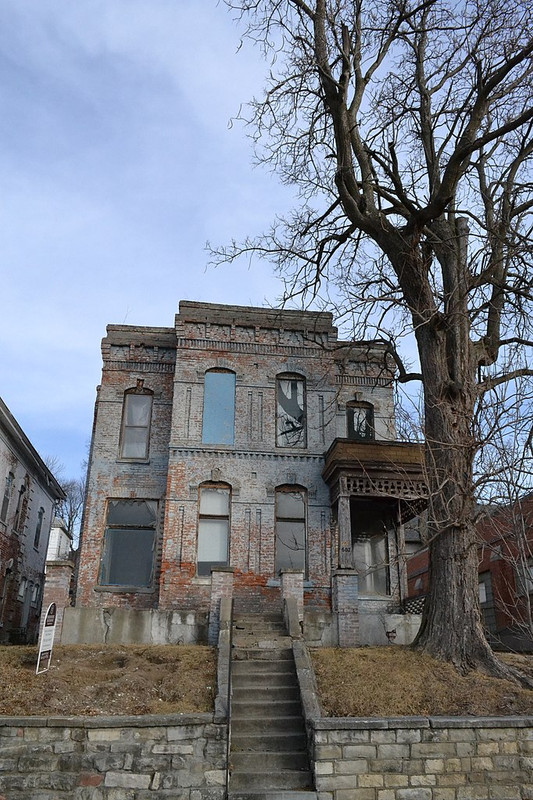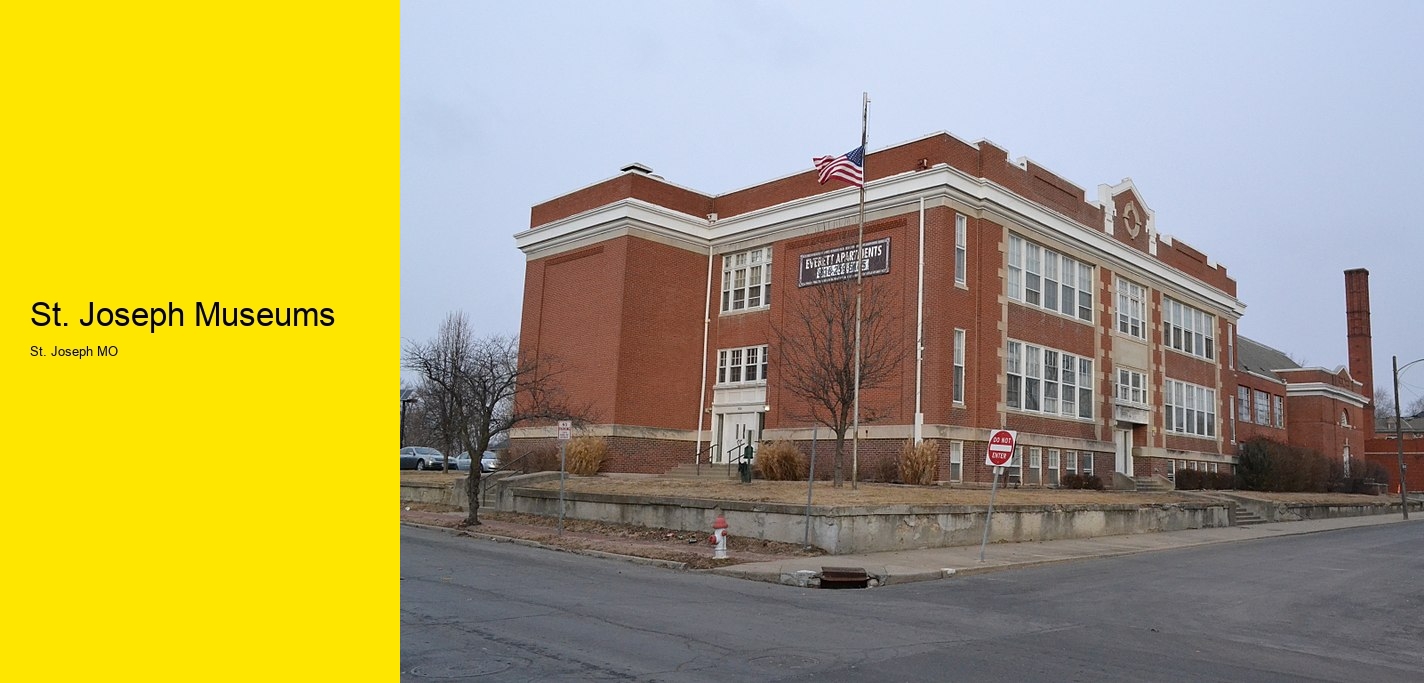St Joseph Museums: The Cultural Institutions In St Joseph Offer A Fascinating Glimpse Into The Region'S History And Heritage
Exploring Cultural Institutions in St. Joseph
Engaging with local heritage can often present challenges for enthusiasts and newcomers alike. Navigating the rich tapestry of art, history, and culture might sometimes feel overwhelming, particularly when sifting through various options that may not resonate with personal interests or expectations. The question of accessibility and relevance often arises, leaving potential visitors hesitant. However, the vibrant cultural venues in this community have anticipated these concerns and crafted experiences that truly shine.
From captivating exhibitions to interactive displays, the institutions around here ensure that every visitor finds something that sparks their curiosity.
St. Joseph Museums - Glore Psychiatric Museum
- Rosecrans Memorial Airport
- Diverse Exhibits: The galleries and collections celebrate a wide range of themes, making sure that various tastes are accommodated.
- Family-Friendly Activities: Engaging programs for all ages ensure that everyone can partake in the joy of discovery.
- Educational Initiatives: Workshops and guided tours provide deeper insights, enhancing the visitor experience.
- Community Engagement: Local events foster a sense of belonging and connection, encouraging participation from residents and tourists alike.
As a visitor, I was thrilled to witness how these cultural havens not only celebrate the local legacy but also embrace innovation. Every corner revealed something extraordinary, transforming what could have been a mundane outing into a memorable adventure. The emphasis on inclusivity and interaction truly sets these establishments apart, making them a cornerstone of the community's vibrant cultural landscape.
Historical Significance of Museums in St. Joseph MO
The cultural fabric of St. Joseph, Missouri, is intricately woven with rich narratives that echo through time. Historical institutions in this vibrant city bear the weight of stories waiting to be unveiled. These establishments serve as vaults of knowledge, safeguarding artifacts that date back to pivotal moments in American history.
St. Joseph Museums - Hindu
- Missouri Senate
Engagement with these collections offers profound insights into the evolution of society, reflecting shifts in cultural paradigms and technological advancements.
St. Joseph Museums - public–private partnership
- public–private partnership
- Educational Programming: Interactive workshops and guided tours make history accessible and engaging for all ages.
- Community Events: Regularly scheduled gatherings foster connections and celebrate shared cultural milestones.
- Curatorial Expertise: Knowledgeable staff curate exhibits that challenge perceptions and inspire curiosity.
These institutions are not merely repositories of the past; they are dynamic spaces that encourage dialogue and reflection. The commitment to preserving and presenting history in innovative ways ensures that both residents and visitors can appreciate the depth of St. Joseph's legacy. By navigating through the past, one can gain a clearer perspective on the present and the potential for the future.
Noteworthy Collections in St. Joseph MO's Cultural Institutions
Engaging with the artistic and historical treasures found in local establishments can often be a journey of discovery. The exhibits on display reflect a tapestry of human experience, showcasing everything from regional folklore to significant artifacts that tell the story of the area. Visitors frequently encounter a myriad of installations that pique curiosity and invite deeper exploration.
In this vibrant locale, one can find a plethora of collections that stand out:
- Historical Artifacts: Items that chronicle the rich past of the region, offering insights into the lives of early inhabitants.
- Contemporary Art: A platform for modern creators, presenting innovative works that challenge traditional perspectives.
- Educational Displays: Engaging setups that facilitate learning, often featuring interactive components for all ages.
As one delves into these exhibits, the significance of preservation becomes clear. Curators and caretakers meticulously ensure that each piece is maintained, allowing history to resonate with current and future generations. Exhibits often rotate, providing fresh experiences for repeat visitors, and keeping the local culture dynamic and engaging.
Insider Tips for Exploring Local Collections
- Visit during special events for unique insights and guided tours led by knowledgeable staff.
- Engage with interactive displays to enhance your understanding and enjoyment of the exhibits.
- Take note of any temporary exhibitions, as they often feature rare items not typically on display.
The commitment to showcasing local history and artistry is palpable. Such institutions not only celebrate the past but also nurture the creative spirit of the community, ensuring that the narrative continues to evolve. The dedication to curating an enriching experience is evident in every corner, making a visit an enlightening adventure.

Educational Programs in St. Joseph MO
Engaging the community with immersive experiences is paramount. A rich array of educational offerings caters to diverse audiences, from curious children to avid history buffs. These programs are not merely lectures; they are dynamic explorations that ignite passion and spark curiosity. Workshops, interactive exhibits, and guided tours provide hands-on learning opportunities that transcend traditional education.
Unique Learning Opportunities
The organization excels in crafting unique learning experiences that resonate with participants. By incorporating local history and culture, they ensure that each program is rooted in the community. Their approach transforms passive learning into an active quest for knowledge.
- Workshops on local craftsmanship
- Interactive history sessions
- Art and culture exhibitions
- Seasonal events that highlight heritage
Insider Tips for Maximizing Your Experience
To truly enhance your visit, consider these expert suggestions:
- Arrive early to explore additional exhibits that may not be part of the program.
- Engage with facilitators; their insights can deepen your understanding.
- Participate in discussions; sharing perspectives enriches the overall experience.
- Check the calendar for special events and themed programs for added excitement.
With a commitment to fostering knowledge and appreciation, this establishment continuously innovates its educational programs, ensuring that every visit is a journey into the past, present, and future of the community.
Events and Activities in St. Joseph MO
Engaging with the vibrant cultural scene in St. Joseph MO often revolves around dynamic exhibitions and interactive experiences that captivate visitors. Enthusiasts frequently seek events that offer immersive learning opportunities, but they may find themselves overwhelmed by the variety of options available. Fortunately, local establishments have meticulously curated programming that alleviates the confusion.
Events range from historical reenactments to art showcases, providing a rich tapestry of experiences that cater to diverse interests. Highlights include:
- Hands-on workshops led by knowledgeable artisans
- Seasonal festivals celebrating local heritage
- Family-friendly activities designed to spark curiosity
- Lectures featuring renowned speakers in various fields
Many of these events are not just surface-level attractions; they delve deep into the community's history and creativity. Creators behind these initiatives understand that fostering a sense of connection is crucial for attendees. They craft experiences that resonate, leaving lasting impressions.
Tips for Maximizing Your Experience
- Arrive early to secure parking and enjoy a leisurely stroll around the venue.
- Check the schedule ahead of time to catch your desired activities.
- Engage with staff; they often have insider knowledge about hidden gems within the exhibits.
- Participate actively-ask questions and share your thoughts!
By fully immersing oneself in the offerings, visitors can transform a simple outing into an unforgettable journey through history and creativity. Local venues excel in making each gathering not just an event, but a memorable experience that reflects the spirit of St. Joseph MO.
Visitor Experience and Accessibility in St. Joseph MO
Navigating the landscape of cultural exploration in St. Joseph can present unique hurdles, particularly when it comes to accommodating diverse needs. Accessibility plays a pivotal role in ensuring that everyone can enjoy the rich tapestry of history and art that this area offers. An awareness of these intricacies allows for a more inclusive atmosphere, transforming the way individuals engage with the various exhibits and collections.
Those who curate and manage the local institutions are keenly attuned to these requirements. They have implemented thoughtful modifications to enhance visitor interaction, such as:
- Wheelchair ramps and accessible restrooms to ensure movement is seamless.
- Guided tours designed for various abilities, allowing everyone to delve into the narratives presented.
- Signage with clear, large print and braille, facilitating easier navigation for all guests.
- Quiet zones for visitors needing a respite from the lively atmosphere.
When planning a visit, consider these expert insights to maximize your experience:
- Check the schedule for special events that might offer unique programming tailored for specific audiences.
- Engage with staff members who are trained to assist with any specific requests or needs.
- Utilize sensory-friendly resources available at the entrance to help prepare for the visit.
Understanding the nuances of visitor accessibility is crucial. The local institutions are committed to fostering an environment where everyone feels welcome and valued, ensuring that each experience is memorable and enriching.
Future Developments and Initiatives in St. Joseph MO's Cultural Landscape
Anticipating the evolving needs of visitors, local cultural institutions are reimagining their approaches to engagement and education. One predominant hurdle faced is attracting younger demographics while retaining the interest of seasoned patrons. Innovating the experience is crucial, and museums are increasingly adopting technology to enhance visitor interaction.
Immersive exhibits utilizing augmented reality and interactive displays are becoming common. This approach not only captivates the audience but also provides an educational layer that resonates with diverse age groups.
St. Joseph Museums - Hindu
- National Collegiate Athletic Association
Strategic Initiatives for Growth
- Development of mobile applications offering virtual tours and gamified experiences.
- Collaboration with local artists and historians to curate unique, community-driven exhibitions.
- Enhanced educational programs that cater to schools, incorporating hands-on learning experiences.
These establishments are committed to fostering a vibrant community connection. They recognize that collaboration with local schools can yield fruitful relationships, turning history into an engaging adventure for younger audiences. Special workshops and family events can provide practical insights into historical contexts, making the past relevant and exciting.
Expert Insights for Enriching Visits
Understanding the unique narratives of a region can significantly enhance the museum experience. Here are some expert tips to make the most of your visit:
- Participate in guided tours to gain deeper insights and uncover hidden stories.
- Check for special events or seasonal exhibitions to experience the latest offerings.
- Engage with docents; their knowledge can illuminate details you might miss.
By embracing innovation and community collaboration, these cultural institutions are poised to thrive, ensuring a dynamic future that honors the past while inspiring the next generation. Such initiatives not only elevate the visitor experience but also solidify the museum's role as a pivotal community hub.
I couldn't be happier with my experience at St. Joseph Museums! The knowledgeable staff provided me with amazing insights and made my visit truly memorable. If you're looking for expert advice and a fantastic opportunity to explore the rich history of St. Joseph, I highly recommend reaching out to them for a free consultation. Don't miss out on the chance to enhance your understanding of this unique destination!
St. Joseph Museums - public–private partnership
- Glore Psychiatric Museum
- Hindu




















